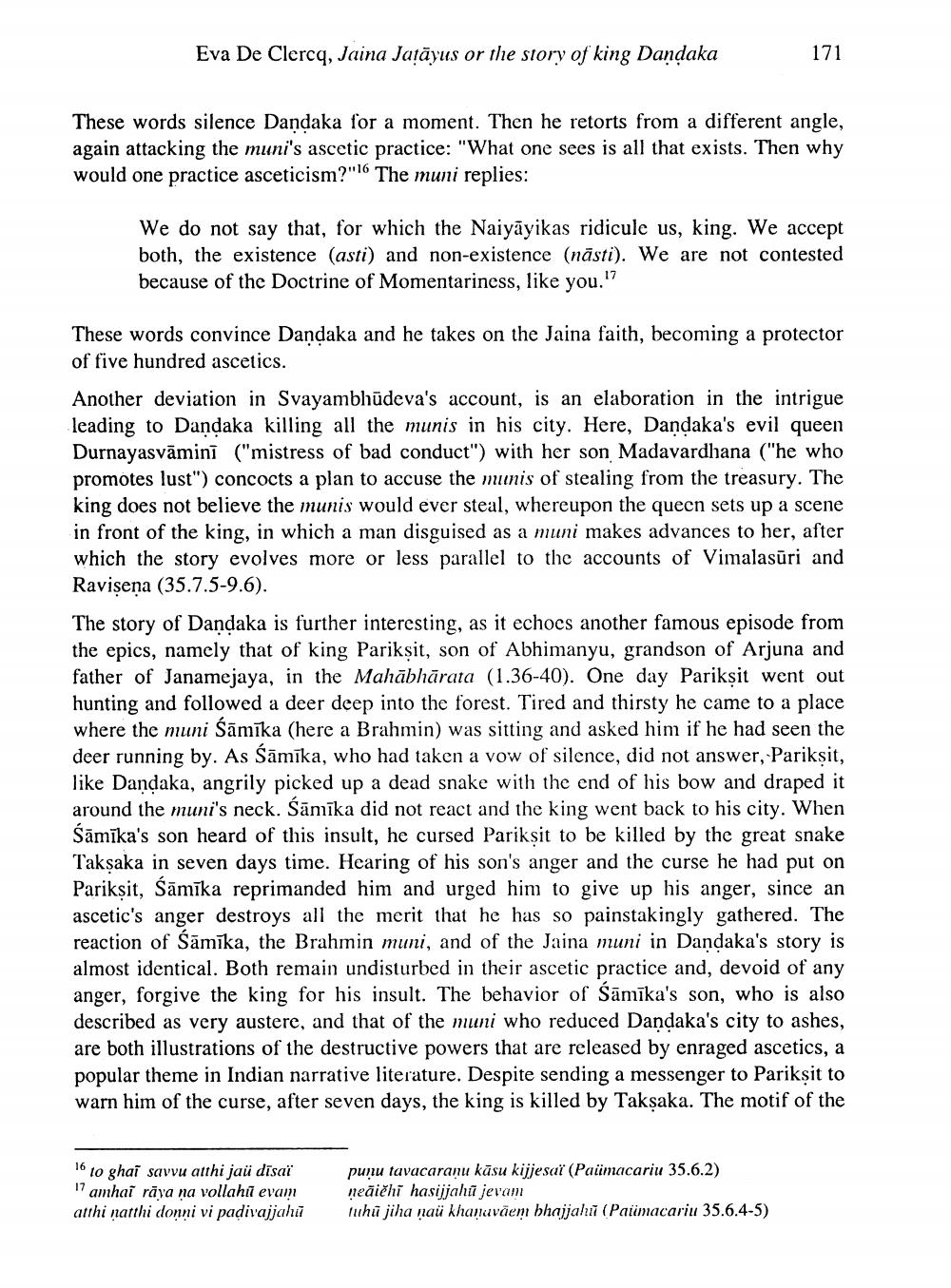________________
Eva De Clercq, Jaina Jatāyus or the story of king Dandaka
171
These words silence Dandaka for a moment. Then he retorts from a different angle, again attacking the muni's ascetic practice: "What one sees is all that exists. Then why would one practice asceticism?"16 The muni replies:
We do not say that, for which the Naiyāyikas ridicule us, king. We accept both, the existence (asti) and non-existence (năsti). We are not contested because of the Doctrine of Momentariness, like you."
These words convince Dandaka and he takes on the Jaina faith, becoming a protector of five hundred ascetics. Another deviation in Svayambhūdeva's account, is an elaboration in the intrigue leading to Dandaka killing all the munis in his city. Here, Dandaka's evil queen Durnayasvāminī ("mistress of bad conduct") with her son Madavardhana ("he who promotes lust") concocts a plan to accuse the munis of stealing from the treasury. The king does not believe the munis would ever steal, whereupon the queen sets up a scene in front of the king, in which a man disguised as a muni makes advances to her, after which the story evolves more or less parallel to the accounts of Vimalasūri and Ravişena (35.7.5-9.6). The story of Dandaka is further interesting, as it echoes another famous episode from the epics, namely that of king Pariksit, son of Abhimanyu, grandson of Arjuna and father of Janamejaya, in the Mahābhārata (1.36-40). One day Pariksit went out hunting and followed a deer deep into the forest. Tired and thirsty he came to a place where the muni Sāmīka (here a Brahmin) was sitting and asked him if he had seen the deer running by. As Sāmīka, who had taken a vow of silence, did not answer, Pariksit, like Dandaka, angrily picked up a dead snake with the end of his bow and draped it around the muni's neck. Sāmīka did not react and the king went back to his city. When Sāmīka's son heard of this insult, he cursed Pariksit to be killed by the great snake Takşaka in seven days time. Hearing of his son's anger and the curse he had put on Pariksit, Sāmīka reprimanded him and urged him to give up his anger, since an ascetic's anger destroys all the merit that he has so painstakingly gathered. The reaction of Sāmīka, the Brahmin muni, and of the Jaina muni in Dandaka's story is almost identical. Both remain undisturbed in their ascetic practice and, devoid of any anger, forgive the king for his insult. The behavior of Sāmīka's son, who is also described as very austere, and that of the muni who reduced Dandaka's city to ashes, are both illustrations of the destructive powers that are released by enraged ascetics, a popular theme in Indian narrative literature. Despite sending a messenger to Pariksit to warn him of the curse, after seven days, the king is killed by Taksaka. The motif of the
16 to ghai savvu atthi jau disai 17 amhai rāva na vollahu evan atthi natthi donni vi padivajjahi
punu tavacaranu kāsu kijjesaf (Paümacariu 35.6.2) neāičhi hasijjahu jevam ruhu jiha naü khanuväem bhaijali (Patimacariu 35.6.4-5)




